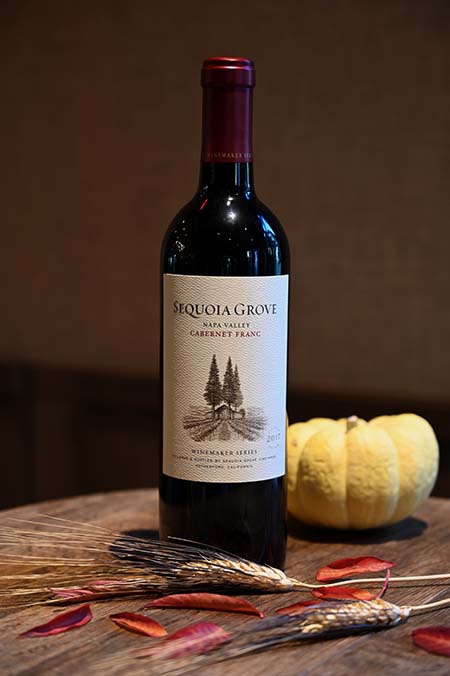Cabernet Franc is growing in popularity all around the world. Well-known as the backbone of most Bordeaux blends, this black-skinned grape is enjoying a new wave of appreciation as a single variety. It has the spice of the Rhône, the elegance of Burgundy, and the structure of Bordeaux. Red wine enthusiasts adore its fragrant complexity, while white wine lovers find Cabernet Franc a gentle segway into red varieties.
For over 40 years, Sequoia Grove Winery has been producing top-quality wine in Rutherford. The Rutherford AVA is recognized for its elusive ‘Rutherford dust effect,’ which derives from the deep soils and unique microclimates that help soften tannins for a cocoa powder finish. As a result, Rutherford is ideal for growing the upper echelons of not only premium Cabernet Sauvignon, but also Cabernet Franc. Sometimes called ‘the other Cabernet,’ Sequoia Grove is proud to produce two single variety bottlings: our Napa Valley and Tonella Single Vineyard Cabernet Franc.

Styles of Cabernet Franc
Few may realize that Cabernet Franc is the parent grape of both Merlot and Cabernet Sauvignon. As such, it has the soft tannins of a Merlot but the structure of a Cabernet Sauvignon. As one of the ‘big five’ varieties used in Bordeaux blends (the other four being Cabernet Sauvignon, Merlot, Petit Verdot, and Malbec), Cabernet Franc is most widely planted in Bordeaux. Yet, it is also equally important in the Loire. Cabernet Franc thrives in the limestone slopes of Chinon and Bourgeil, where the cooler growing conditions serve to accentuate the grape’s grassy herbaceousness and pencil lead aromas.
Outside of France, Cabernet Franc is also a staple in Argentina. Unlike Malbec or Cabernet Sauvignon, Cabernet Franc thrives in Argentina’s cooler or high-altitude vineyards across the country, particularly along the Andes. Across the board, Argentinian Cabernet Franc is richer and more voluptuous than those found in regions like the Loire and still displays the classic green pepper and herbal tones that are the variety’s signature.
Back on home soil in Napa Valley, the first known Cabernet Franc in the region was planted in 1949 in Detert Vineyard (originally part of the To Kalon Vineyard). The original site was approximately 17 acres of Cabernet Franc. Since then, the variety has enjoyed an interest in uptake, despite it being quite a challenging grape to work with.
“Cabernet Franc is known for needing a lot of attention to detail. It’s expensive to cultivate and requires occasional green harvests,” explains Sequoia Grove Winemaker Jesse Fox.
This probably accounts for the fact that in Napa Valley there are currently only 1,211 acres of Cabernet Franc to Cabernet Sauvignon’s 24,354 acres. Adding to this is the fact that Cabernet Franc hasn’t always had the best reputation in the wine world. Cabernet Franc has often been regarded as a vineyard underdog, criticized for exhibiting ‘green’ charatertisitcs. Yet, Sequoia Grove has championed the variety for decades, with winemakers like our very own Jesse advocating for the grape’s potential:
“Napa Valley has the right climate and the right soils for Cabernet Franc. Besides aging as well as a Cabernet Sauvignon, it is also wonderfully versatile to work with in the cellar. Whether a wine needs a bit more fruit or a bit more spice, Cabernet Franc is the perfect go-to,” Jesse remarks.
Why Try Cabernet Franc?
While not only offering value for money, Cabernet Franc delivers three distinct sets of aromas on the nose: fruit, spice, and herbaceousness. It’s a true all-rounder and is flexible with food. At Sequoia Grove, we are proud to offer two different Cabernet Francs for you to explore: the Napa Valley and Tonella Vineyard Cabernet Franc.
A winery exclusive, the Napa Valley Cabernet Franc showcases the classic ‘Rutherford dust effect,’ with background notes of cinnamon and cocoa powder. The palate is bright and balanced with food-friendly acidity and a toasty vanilla finish. Rated “Best in Class” by the San Francisco Chronicle Wine Competition, this is a bottle that combines value with a wow-factor.
[BUY 2017 NAPA VALLEY CABERNET FRANC]
For those wanting to experience Cabernet Franc’s true Rutherford potential, the Tonella Vineyard Cabernet Franc delivers in spades. The Tonella Estate Vineyard includes 7 acres of prime Single Vineyard Cabernet Franc grown across three unique blocks. Blocks 7A and 7B are made up of red, rocky volcanic soil that leads to early ripening, making this one of the first blocks to be picked each vintage. This block brings an important depth of flavor and richness to the final blend. Block 10A sits on Olympic Stony clay loam, and is rocky and reddish in color. The Cabernet Franc from this site brings red fruit and savory stone notes to the wine. As a result, the Tonella Vineyard is bright with aromas of lavender, violets, raspberries, fig preserves, and vanilla. On the palate, this wine has mouth-quenching acidity, hints of graphite, and dusty tannins, exemplifying Rutherford terroir.
[BUY 2017 TONELLA CABERNET FRANC]
While Cabernet Sauvignon will most likely always remain the king of Napa Valley, there is increasing attention being paid to the amazing wines that Cabernet Franc can produce. Like Cabernet Sauvignon, Cabernet Franc has power, but there is an elegance and silkiness to the tannin structure. For this reason, Cabernet Franc is sometimes described as an “iron fist wearing a velvet glove.” While for now the variety may be seen as ‘the other Cabernet’ and it still a relatively hidden gem, don’t underestimate it – Cabernet Franc certainly packs a punch.